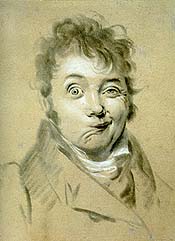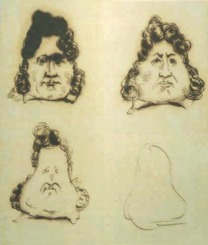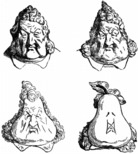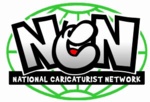

Caricature is most common in drawings and editorial cartoons, but Honoré Daumier (French, 1808-1879) made several sculptural examples.
(pr. ca"ri-kuh-chuhr')
Examples:
William Hogarth (English, 1697-1794), Over 100 faces, illustrating the infinite variety of expression, 1743, etching on paper, height 24 cm. See expression.
Francisco José de Goya y Lucientes (Spanish, 1746-1828), It's Your Saint's Day (Es el Dia de su Santo), 1796, brush and gray wash, 0.235 x 0.146 m, Louvre.
James Gillray (English, 1756-1815).

Léopold Boilly (French, 1761-1845),
Grimacing Man (Self-Portrait), c. 1822-23, conté
crayons on paper, collection
of Karen B. Cohen. See expression, French art.,
Neoclassicism,
and self-portrait.

Charles Philipon (French, 1800-1862), La Métamorphose
du roi Louis-Philippe en poire (The Metamorphosis of King Louis-Philippe
into a Pear), c. 1831, pen
and bister-ink drawing, Bibliotheque Nationale de France,
 Paris.
Paris.
See these sketches as they were redrawn
for publication in Charivari
in 1834.
The set of four stages of a metamorphosis begins with an accurate portrait of King Louis-Philippe (1830-1848) whose face Philipon gradually transformed into a pear. The pear immediately was taken as a symbol of the soft, overweight king. Louis-Philippe, the so-called "Citizen King" was a favorite target of republican caricaturists, including Honoré Daumier, until censorship was reinstated in September 1835.

Honoré Daumier (French,
 1808-1879), François-Pierre-Guillaume Guizot,
1831, terra cruda (unfired
clay) bust
painted with oil,
22 x 17 cm, Musée d'Orsay, Paris.
1808-1879), François-Pierre-Guillaume Guizot,
1831, terra cruda (unfired
clay) bust
painted with oil,
22 x 17 cm, Musée d'Orsay, Paris.
Compare Daumier's caricature to a photo of Guizot.

Honoré Daumier, Charles Philipon (1800-1861),
Journalist and Director of the Magazines Caricature
and Charivari, c.1833, terra cruda (unfired clay)
bust painted
with oil, Musée
d'Orsay, Paris, France. See many more of Daumier's clay caricatures
at ABC Gallery.
Harry Furniss (English), Gladstone (1809-1898), the British political leader who served as prime minister four times between 1868 and 1894.
Thomas Nast (American , 1840-1902)

Sir Max Beerbohm (English, 1872-1956), from
"Rossetti and his Friends", Ford Madox Brown being Patronized by Holman Hunt,
1916, pencil and watercolor
on paper, 32.6 x 39.7 cm, Tate
Gallery, London. Ford and Brown were painters associated with
the Pre-Raphaelite
Brotherhood.

Sir Max Beerbohm, from "Rossetti and
his Friends", The Name of Dante Gabriel Rossetti is Heard for
the First Time in the Western States of America, 1916,
pencil and watercolor on paper,
40.0 x 36.8 cm, Tate Gallery, London. Oscar Wilde is portrayed
holding a lily as he speaks to an audience in the American West.
See aestheticism and fin de siècle.
Samuel Klemke (American, 1957-), Crunchy Water Festival, a catastrophic road tale, parts 1 [164 k], 2 [108 k], 3 [108 k], 4 [344 k], 1998, pencil?, collection of the artist. Sam Klemke is one of the great nomadic caricaturists -- an artist who sets up his easel amidst a display of his work at one festival or fair after another. Crunchy Water Festival is in autobiographical narrative about a bad day on the job. See Klemke's site.
Samuel Klemke, Gil, parts 1 , 2 , 3 , 4 , 5 , 1998, pencil?, collection of the artist. Gil is a fond remembrance of an old friend and fellow caricaturist. These two works by Sam Klemke appear here exclusively.

Also see expression and expressionism.
https://inform.quest/_art
Copyright © 1996-![]()